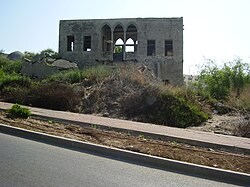Bezeth
| Al-Bassa | |
|---|---|

House of El Khouri Family (2008)
|
|
| Arabic | البصة |
| Also spelled | Bezeth |
| Subdistrict | Acre |
| Coordinates | 33°04′34″N 35°08′27″E / 33.07611°N 35.14083°ECoordinates: 33°04′34″N 35°08′27″E / 33.07611°N 35.14083°E |
| Palestine grid | 164/276 |
| Population | 2,950 (1945) |
| Area | 25,258 dunams 25.2 km² |
| Date of depopulation | 14 May 1948 |
| Cause(s) of depopulation | Expulsion by Yishuv forces |
| Secondary cause | Military assault by Yishuv forces |
| Current localities | Betzet,Rosh HaNiqra,Shlomi,Tzahal,Matzuva |
al-Bassa' (Arabic: البصة), also known as Betzet in Hebrew: בצת, was a Palestinian Arab village in the Mandatory Palestine's Acre Subdistrict. It was situated close to the Lebanese border, 19 kilometers (12 mi) north of the district capital, Acre, and 65 meters (213 ft) above sea level.
The village was stormed by Haganah troops in May 1948 and almost completely razed. Its residents were either internally displaced or expelled to neighboring countries.
Bassa has been identified with the border town Betset (בצת) listed in the Tosefta and the Jerusalem Talmud as subject to the laws of Shmita. It was called Bezeth during the Roman period, and its Arabic name is al-Basah. In the period of Crusader rule in Palestine, it was known as Le Bace or LeBassa.Imad ad-Din al-Isfahani (d. 1201), a chronicler and advisor to Saladin, referred to the village as Ayn al-Bassa.
The site shows signs of habitation in prehistory and the Middle Bronze Age. It was a Jewish settlement between 70 and 425 AD. Blown glass pitchers uncovered in a tomb in al-Bassa were dated to circa 396 AD. An ancient Christian burial place and 18 other archaeological sites were located in the village.
The Survey of Western Palestine, sponsored by the Palestine Exploration Fund, identified al-Bassa as, "probably a Crusading village"; however, archaeological excavations uncovered evidence of an ecclesiastical farm in operation there between the 5th to 8th centuries, and pottery sherds indicate continuous inhabitation throughout the Middle Ages.
...
Wikipedia

